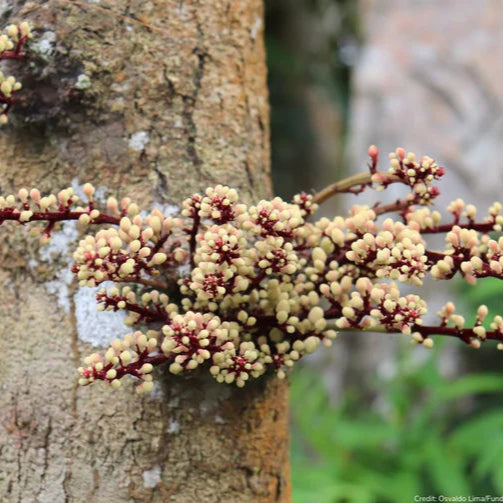Love it? Add to your wishlist
Your favorites, all in one place. Shop quickly and easily with the wishlist feature!
[message]
[title]
[message]


Veliyath Gardens
Couldn't load pickup availability
At Veliyath Gardens, we are dedicated to curating rare and exotic plants that carry both ecological value and horticultural beauty. Among these botanical treasures is the Chytranthus mannii, a little-known but extraordinary fruit tree native to the islands of São Tomé e Príncipe, off the west coast of Africa. Classified by the IUCN Red List as “Near Threatened”, this species holds not just horticultural charm but also deep conservation importance.
Botanical Name: Chytranthus mannii
Family: Sapindaceae (the soapberry family, which also includes lychee and rambutan)
Common/Local Names: While little is documented outside its native habitat, it is sometimes referred to as the “Velvet Violet Fruit Tree” due to its pear-like fruits with a striking violet peel.
Native Range: Endemic to the humid tropical forests of São Tomé e Príncipe, where it grows scattered in lowland and mid-altitude zones.
This plant’s limited distribution and unique traits make it a rare addition for collectors and plant enthusiasts worldwide.
Cultivating Chytranthus mannii outside its native environment requires replicating the humid, equatorial conditions of São Tomé e Príncipe:
Climate: Thrives in humid tropical to subtropical zones, where rainfall is evenly distributed throughout the year.
Soil: Prefers fertile, well-draining loamy soils rich in organic matter. The soil should hold moisture but never remain waterlogged.
Sunlight: Grows well in partial shade to full sunlight. Too much shade reduces fruiting, while strong sunlight enhances growth.
Watering: Requires consistent moisture. Irrigation is crucial in dry periods to mimic its natural rainforest habitat.
Fertilization: Seasonal feeding with organic compost, leaf mulch, or balanced NPK fertilizers supports steady growth.
Time to Fruit: This tree demands patience, as it usually takes 5–7 years before producing its first fruits. However, the exotic payoff is worth the wait.
Maintenance Level: Moderate. Regular watering, seasonal pruning, and soil nourishment are necessary.
One of the most intriguing aspects of this plant is the growth habit of its fruit.
Appearance: The fruits grow directly on the trunk and main branches (a phenomenon known as cauliflory, also seen in cacao and jaboticaba). This adds dramatic beauty when the tree is laden with clusters of violet, velvety fruits.
Shape: Distinctive triangular form—unlike common round or oval fruits.
Color & Texture: Violet skin with a velvety touch.
Taste & Consistency: Soft and pear-like, mildly sweet when ripe, with subtle earthy undertones. The flavor is pleasant though not overly fragrant, making it a refreshing snack fruit.
Although modern scientific studies on Chytranthus mannii are limited, its family (Sapindaceae) and traditional uses suggest multiple benefits:
Nutrient Source: Likely rich in vitamin C, fiber, and minerals, supporting immunity and digestion.
Digestive Health: The pear-like pulp may help regulate bowel movements and provide hydration.
Antioxidant Properties: The violet skin suggests anthocyanins, compounds known for protecting cells against oxidative stress.
Skin & Cellular Protection: As with many tropical fruits, regular consumption may support skin vitality and overall wellness.
The fruits of Chytranthus mannii are primarily enjoyed fresh, but their unique appearance and pear-like consistency also open doors for creative uses:
Fresh Eating: Sweet and juicy, best eaten when fully ripe.
Desserts: Can be incorporated into fruit salads, tarts, or eaten alongside yogurt.
Preserves: The mild sweetness makes it suitable for jams or compotes.
Beverages: Fresh juice or pulp blends well with tropical smoothies.
Because of its rarity, culinary use is mostly confined to its native regions, making it an exotic treat elsewhere.
Indigenous communities of São Tomé e Príncipe have long valued wild fruits for nutrition and folk remedies, and Chytranthus mannii is no exception. Though records are limited, the fruit is believed to:
Aid in hydration and cooling during hot, humid climates.
Be used in simple remedies for stomach discomfort.
Provide nutritive support postpartum, similar to other Sapindaceae fruits.
Further scientific studies may reveal deeper medicinal potential, as seen with relatives like lychee and longan.
Rare Exotic: Its limited distribution makes it a collector’s treasure.
Unique Fruits: Violet, triangular, trunk-growing fruits unlike anything else in a fruit garden.
Conservation Value: By cultivating this tree, growers directly contribute to preserving a species listed as “Near Threatened.”
Culinary & Nutritional Delight: Sweet, pear-like fruits with both aesthetic and dietary appeal.
Garden Showpiece: The cauliflorous fruiting style makes it an ornamental spectacle as well as a food source.
The Chytranthus mannii Live Plant is more than just a fruit tree—it is a symbol of biodiversity, conservation, and exotic beauty. Though it requires patience to bear fruit, the rewards are extraordinary: clusters of violet, velvety fruits with a pear-like sweetness, grown right on the trunk. Cultivating this plant in your exotic fruit garden not only gives you a rare and beautiful harvest but also supports the survival of a species edging toward risk.
At Veliyath Gardens, we are delighted to make this rare gem available for plant enthusiasts, collectors, and conservation-minded gardeners. Add this living treasure to your garden, and experience the satisfaction of nurturing one of the world’s rarest and most unique fruit plants.
Climate: Thrives in humid tropical to subtropical zones, where rainfall is evenly distributed throughout the year.
Soil: Prefers fertile, well-draining loamy soils rich in organic matter. The soil should hold moisture but never remain waterlogged.
Sunlight: Grows well in partial shade to full sunlight. Too much shade reduces fruiting, while strong sunlight enhances growth.
Nutrient Source: Likely rich in vitamin C, fiber, and minerals, supporting immunity and digestion.
Digestive Health: The pear-like pulp may help regulate bowel movements and provide hydration.
Antioxidant Properties: The violet skin suggests anthocyanins, compounds known for protecting cells against oxidative stress.
The Chytranthus mannii Live Plant is more than just a fruit tree—it is a symbol of biodiversity, conservation, and exotic beauty. Though it requires patience to bear fruit, the rewards are extraordinary: clusters of violet, velvety fruits with a pear-like sweetness, grown right on the trunk.



